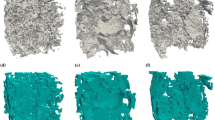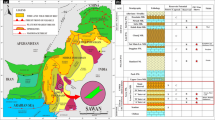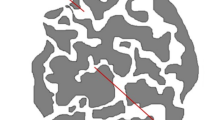Abstract
In this study, several chemical grouting tests of fractured porous sandstone were performed based on the low-field nuclear magnetic resonance (NMR) technology, and the nuclear magnetic signal characteristics (NMR T2) of slurry were tracked and tested in real-time. The variations in the injected slurry volume, effective grouting time and slurry permeability with different confining pressures, injection pressures and fracture inclination angles were quantitatively analysed. Besides, the relative filling degree (RFD) was proposed to comprehensively investigate the diffusion processes under different grouting conditions. The results indicate that both the high confining pressure (e.g., 20 MPa) and large fracture inclination angle (e.g., 27°) induce the decrease in injected slurry volume by the rate of 16.7 and 44%, while the effects induced by injection pressure is not obvious. The permeability of slurry in fractured porous sandstone linearly decrease as the confining pressure and fracture inclination angle increase, coinciding with the decrease amplitude of 67.1 and 44%, respectively. The slurry diffusion pattern in fractured porous sandstone is strongly dependent on the confining pressure, injection pressure and fracture inclination angle. Both the relative filling degrees of rock pores and fractures decrease with increasing confining pressure and fracture inclination angle.
Highlights
-
The diffusion processes of chemical slurry under several external conditions and grouting parameters have been monitored in real-time by the low-field NMR technique.
-
The variations in the injected slurry volume and diffusion patterns with different grouting conditions were comprehensively studied.
-
The expression of the relative filling degree of slurry in fractured porous sandstone was proposed. And the effects of various grouting conditions on the relative filling degree were analyzed based on the evolution of NMR T2 curves.













Similar content being viewed by others
Data Availability
The data that support the findings of this study can be available from the corresponding author upon reasonable request.
Abbreviations
- T 2 :
-
The total transverse relaxation time
- T S :
-
The surface relaxation time
- T D :
-
The diffusion relaxation time
- T B :
-
The bulk relaxation time
- k eff :
-
The growth rate of effective grouting section
- k w :
-
The growth rate of overall grouting section
- n sta :
-
The increased slurry volume in the stable stage
- n eff :
-
The increased slurry volume in the effective grouting stage
- t eff :
-
The start time of the effective grouting stage
- t sta :
-
The duration of the whole grouting stage
- RFD t :
-
Relative filling degree at different grouting time
- S :
-
The peak area of NMR T2 curve under different external and grouting conditions at different grouting time
- t :
-
The grouting time
- i :
-
The peak number, i = 1, 2
- j :
-
The various grouting conditions (confining pressure, injection pressure and fracture inclination angle)
- S max :
-
The maximum peak area under different grouting conditions when the grouting tests were completed
- K ab :
-
The intrinsic permeability coefficient
- K ab f :
-
The intrinsic permeability coefficient of fracture
- K ab p :
-
The intrinsic permeability coefficient of pores
- Q :
-
The injected slurry volume
- μ :
-
The slurry viscosity
- ΔP :
-
The grouting pressure
- L :
-
The length of the specimen
- A :
-
The cross sectional area of the specimen
References
Deng JQ, Lin C, Yang Q, Liu YR, Tao ZF, Duan HF (2016) Investigation of directional hydraulic fracturing based on true tri-axial experiment and finite element modeling. Comput Geotech 75(12):28–47
Draganović A, Stille H (2011) Filtration and penetrability of cement-based grout: Study performed with a short slot. Tunn Undergr Space Technol 26(4):548–559
Duan WG, Sun BJ, Pan D, Wang T, Guo TK, Wang ZY (2021) Experimental study on fracture propagation of hydraulic fracturing for tight sandstone outcrop. Energy Explor Exploit 39(1):156–179
Fernandez A, Vazquez T, Palomo A (2011) Effect of sodium silicate on calcium aluminate cement hydration in highly alkaline media: a microstructural characterization. J Am Ceram Soc 94(4):1297–1303
Fu YB, Wang XL, Zhang SZ (2019) Modelling of permeation grouting considering grout self-gravity effect: theoretical and experimental study. Adv Mater Scie Eng 10:11–23
Funehag J, Thorn J (2018) Radial penetration of cementitious grout-Laboratory verification of grout spread in a fracture model. Tunn Undergr Space Technol 72(4):228–232
Gan L, Shen ZZ, Xiao M (2020) Experimental investigation of seepage characteristics in porous rocks with a single fracture. Hydrogeol J 28(8):2933–2946
Han CH, Zhang WJ, Zhou WW, Guo JB, Yang F, Man XQ, Jiang JG, Zhang CR, Li YJ, Wang Z, Wang H (2020) Experimental investigation of the fracture grouting efficiency with consideration of the viscosity variation under dynamic pressure conditions. Carbonates Evaporites 35(2):18–32
Hao MM, Li XL, Zhong YH, Zhang B, Wang FM (2021) Experimental study of polyurethane grout diffusion in a water-bearing fracture. J Mater Civ Eng 33(3):120–132
Javadi M, Sharifzadeh M, Shahriar K (2010) A new geometrical model for non-linear fluid flow through rough fractures. J Hydrol 389(1):18–30
Jiang XM, Zheng GS, Sui WH, Chen JX, Zhang JC (2021) Anisotropic propagation of chemical grouting in fracture network with flowing water. ACS Omega 6(7):4672–4679
Kazemian S, Prasad A, Huat BB, Bazaz JB, Mohammed TA, Aziz FN (2011) Effect of aggressive pH media on peat treated by cement and sodium silicate grout. J Cent South Univ Technol 18(3):840–847
Lee SH, Lee KK, Yeo IW (2014) Assessment of the validity of stokes and reynolds equations for fluid flow through a rough-walled fracture with flow imaging. Geophys Res Lett 41(13):4578–4585
Li H, Zhang Y, Wu J, Zhang X, Zhang L, Li Z (2020) Grouting sealing mechanism of water gushing in karst pipelines and engineering application. Constr Build Mater 254(11):119–132
Li MY, Wu ZJ, Weng L, Liu QS, Chu ZF (2022) Quantitative relationships between the mineral composition and macro mechanical behaviors of granite under different temperatures: Insights from mesostructure-based DEM investigations. Comput Geotech 148(10):38–48
Liang Y, Sui W, Qi J (2019) Experimental investigation on chemical grouting of inclined fracture to control sand and water flow. Tunn Undergr Space Technol 83(6):82–90
Liu QS, Sun L (2019) Simulation of coupled hydro-mechanical interactions during grouting process in fractured media based on the combined finite-discrete element method. Tunn Undergr Space Technol 84(2019):472–486
Liu QS, Sun L, Tang XH (2019) Investigate the influence of the in-situ stress conditions on the grout penetration process in fractured rocks using the combined finite-discrete element method. Eng Anal Boundary Elem 106(12):86–101
Liu B, Sang HM, Liu QS, Liu H, Pan YC, Kang YS (2021a) Laboratory study on diffusion and migration of grout in rock mass fracture network. Int J Geomech 21(1):56–78
Liu XW, Chen HX, Liu QS, Liu B, He J (2021b) Modelling slurry flowing and analyzing grouting efficiency under hydro-mechanical coupling using numerical manifold method. Eng Anal Boundary Elem 134(10):66–78
Liu XW, Hu C, Liu QS, He J (2021c) Grout penetration process simulation and grouting parameters analysis in fractured rock mass using numerical manifold method. Eng Anal Boundary Elem 123(4):93–106
Lunn RJ, Corson LT, Howell C, Mountassir G, Reid C, Harley SL (2018) Could magnetic properties be used to image a grouted rock volume. J Appl Geophys 155(2):162–175
Raven KG, Gale JE (1985) Water flow in a natural rock fracture as a function of stress and sample size. Int J Rock Mech Min Sci 22(4):251–261
Salimian MH, Baghbanan A, Hashemolhosseini H, Dehghanipoodeh M, Norouzi S (2017) Effect of grouting on shear behavior of rock joint. Int J Rock Mech Min Sci 98(2):159–166
Sharmeen R, Illman WA, Berg SJ, Yeh TCJ, Park YJ, Sudicky EA, Ando K (2012) Transient hydraulic tomography in a fractured dolostone: Laboratory rock block experiments. Water Resour Res 48(12):58–81
Sui WH, Qu H, Gao Y (2015) Modeling of grout propagation in transparent replica of rock fractures. Geotech Test J 38(5):765–773
Sun L, Grasselli G, Liu QS, Tang XH (2019) Coupled hydro-mechanical analysis for grout penetration in fractured rocks using the finite-discrete element method. Int J Rock Mech Min Sci 124(2):11–15
Sun L, Liu QS, Abdelaziz A, Tang XH, Grasselli G (2022) Simulating the entire progressive failure process of rock slopes using the combined finite-discrete element method. Comp Geotech. 141:104557
Tian ML, Han LJ, Meng QB (2020) Experimental study on the mechanical performance of grouted specimen with composite ultrafine cement grouts. KSCE J Civ Eng 24(1):38–48
Wang C, Jiang Y, Liu R, Wang C, Zhang Z, Sugimoto S (2020) Experimental study of the nonlinear flow characteristics of fluid in 3d rough-walled fractures during shear process. Rock Mech Rock Eng 53(6):2581–2604
Weng L, Wu ZJ, Zhang SL, Liu QS, Chu ZF (2022) Real-time characterization of the grouting diffusion process in fractured sandstone based on the low-field nuclear magnetic resonance technique. Int J Rock Mech Min Sci 152(1):15–22
Wong LNY, Li D, Liu G (2013) Experimental studies on permeability of intact and singly jointed meta-sedimentary rocks under confining pressure. Rock Mech Rock Eng 46(1):107–121
Wong LNY, Zhang YH, Wu ZJ (2020) Rock strengthening or weakening upon heating in the mild temperature range? Eng Geol 272(10):26–30
Wu J, Yin Q, Jing H (2020) Surface roughness and boundary load effect on nonlinear flow behavior of fluid in real rock fractures. Bull Eng Geol Env 79(9):4917–4932
Wu ZJ, Lu H, Weng L, Liu QS, Shen JQ (2021) Investigations on the seepage characteristics of fractured sandstone based on NMR real-time imaging. Chin J Rock Mech Eng 40(2):263–275
Yang SQ, Huang YH, Jiao YY, Zeng W, Yu QL (2015) An experimental study on seepage behavior of sandstone material with different gas pressures. Acta Mech Sin 31(6):837–844
Yang P, Liu YH, Gao SW, Xue SB (2020) Experimental investigation on the diffusion of carbon fibre composite grouts in rough fractures with flowing water. Tunn Undergr Space Technol 95(6):68–81
Zhang CQ, Cui GJ, Chen XR, Zhou H, Deng L (2020) Effects of bolt profile and grout mixture on shearing behaviors of bolt-grout interface. J Rock Mech Geotech Eng 12(2):242–255
Zhou Y, Wu ZJ, Weng L, Liu QS (2021) Seepage characteristics of chemical grout flow in porous sandstone with a fracture under different temperature conditions: An NMR based experimental investigation. Int J Rock Mech Min Sci 142(10):47–64
Zhu MT, Zhang QS (2018) Zhang X and Hui B (2018) Comparative Study of Soil Grouting with Cement Slurry and Cement-Sodium Silicate Slurry. Adv Mater Sci Eng 3:28–40
Zou LC, Hakansson U, Cvetkovic V (2019) Cement grout propagation in two-dimensional fracture networks: Impact of structure and hydraulic variability. Int J Rock Mech Min Sci 115(2):1–10
Acknowledgements
The research work is supported by the National Natural Science Foundation of China (Grant Nos. 51974289 and U22A20234).
Author information
Authors and Affiliations
Contributions
YZ Conceptualization, Methodology, Investigation, Data Curation, Writing. BL Data Curation, Resources, Funding acquisition. ZW Conceptualization, Writing-Review& Editing. YJ Validation, Writing-Review& Editing. QL Supervision. ML Validation, Writing-Review& Editing. LW Methodology.
Corresponding author
Ethics declarations
Conflict of Interest
The authors declare that they have no known competing financial interests or personal relationships that could have appeared to influence the work reported in this paper.
Additional information
Publisher's Note
Springer Nature remains neutral with regard to jurisdictional claims in published maps and institutional affiliations.
Rights and permissions
Springer Nature or its licensor (e.g. a society or other partner) holds exclusive rights to this article under a publishing agreement with the author(s) or other rightsholder(s); author self-archiving of the accepted manuscript version of this article is solely governed by the terms of such publishing agreement and applicable law.
About this article
Cite this article
Zhou, Y., Liu, B., Wu, Z. et al. Experimental Investigation on the Grouting Diffusion Characteristics and Relative Filling Degree of Chemical Slurry in Fractured Porous Sandstone. Rock Mech Rock Eng 56, 7819–7837 (2023). https://doi.org/10.1007/s00603-023-03463-4
Received:
Accepted:
Published:
Issue Date:
DOI: https://doi.org/10.1007/s00603-023-03463-4




